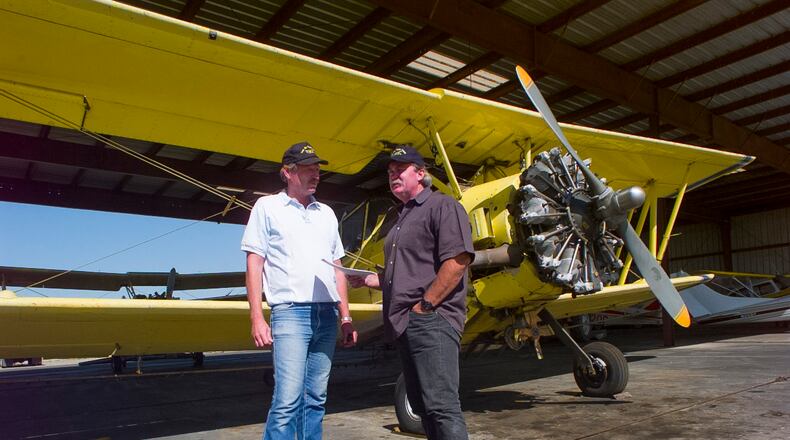The plane banked sharply, reversed course and came across the field again, laying another trail of mist. After a few passes it droned away across the wide, flat fields, flying just high enough to avoid power lines.
This is farming, Sacramento style.
My partner, Ty Greenlees, and I made an overnight stop here Sunday on our two-week flight around the nation. We stayed with Ty's cousin, Tara Atkinson, who works for the California Farm Bureau. She drove us to Riego Field, a private airstrip and the home of Farm Air, an agricultural aviation business.
Bill Porter, a big, mustachioed man who co-owns Farm Air with John Warner, showed us their four-plane fleet of yellow cropdusters - and explained that `cropduster' is a misnomer for their work.
"Most people have no idea that ag aviation has anything to do with anything besides spreading chemicals," Porter said. “Seventy-five percent of what we do is seeding.”
Farm Air seeds about 35,000 acres in the Sacramento area with rice, clover, alfalfa and a variety of grains. It uses liquid sprays to treat crops. Monday morning, we watched one of Farm Air's Grumman Ag Cats treat a cornfield for mites.
Porter said "cropdusting" is a throwback to the early days of aerial agriculture. "In those days, everything was done in dust form, so it went everywhere," he said. "Most places in the country, cropdusters are sprayers," he said.
Agricultural aviation is just one facet of the wide realm of flying known in the United States as general aviation. It encompass all forms of aviation besides scheduled airlines and military aviation.
Like many in general aviation, Porter feels the public doesn't appreciate the importance of ag aviation to the economy and to society. Simply put, a lot of the food we eat depends on cropdusters for seeding, fertilization and pest control.
"People don't think much about where their food comes from," Porter said
We found the same situation back in Lordsburg, N.M. Lordsburg Airport was literally a port in a storm for us Friday night. It was an attractive, well-lighted runway where the airport manager, John Heemsbergen, lives with his wife, Anna Lee. They gave us a friendly welcome and let us borrow a courtesy car overnight.
Heemsbergen said the airport is also an economic asset for Lordsburg, a town of 3,500 in the middle of nowhere. "Everybody who comes into town, whether they're building a motel or a truck stop or working on the gas pipes, comes through this door," Heemsbergen said. "The people who come in here pour money into this town."
But Heemsbergen complained that local officials see the airport not as an economic asset, but as a place where wealthy people fly for pleasure. As a result, he said, the town won't invest in projects such as new hangars that would stimulate more business at the airport.
Heemsbergen said he and his wife are leaving the airport this year after three years. "We basically make our living selling airplanes," he said. "I think I'm going to buy 80 acres that's narrow and long and build my own strip."







